Desserts are undoubtedly the most tempting of all foods and most us perhaps swear allegiance to it like nothing else. But as much as we love our desserts and savouries, bitter foods too make an interesting, and for some, an integral component of our diet; may that be a cup of coffee, arugula or radicchio or broccoli in our salad, marmalade on our toast, collard greens in a curry or soup, mustard green in our Saag, turmeric in a glass of hot milk or spinach parathas. My taste buds especially have a penchant for bitter foods. Growing up I never liked the milk chocolates and all my friends thought I was a weirdo to not love chocolates. I found the chocolates to be overly sweet, at least the ones that were available at that time in India.
It wasn’t until my brother went abroad on a junket and brought back some chocolates that I learnt of another world – that of dark chocolates. To my advantage, the ones that I liked the most were not touched by anyone else in the family coz everyone found them to be too bitter. On hind sight I can’t blame them for not liking those dark chocolates coz their taste buds had comfortably adapted themselves to the sugary milk chocolates. However, my thoughts then were “Are you kidding me!? These are out of the world”. I specifically remember these particular dark chocolates that were shaped like small flat discs, filled with strawberry, champagne and bitter almonds. They were heavenly!! And that is how my love affair with chocolates began.
Similarly, I love coffee although I am not able to have it because the caffeine does not suit me. In my view any food can taste good depending how it has been ‘treated’ or cooked. For instance, these Indian gooseberries taste quite bitter and sour but treating them with alum and cooking them in sugar syrup changes their character and makes them a nice and healthy treat to enjoy after a meal in winters. Similarly this dry ginger concoction tastes heavenly when cooked in cream and sugar. It is ideal for the winter season and can help keep flu or sore throat at bay. Amongst the summer vegetables, I like karela (bitter melon or bitter gourd). This Karela Alu stir fry is a really scrumptious summer treat to be enjoyed with tandoori roti and a glass of lassi.
Ayurveda advices that one should activate and gratify all sensory buds on the tongue i.e. sweet, salty, bitter, sour and pungent. We tend to incorporate sweet, salt and savory in our diet but bitter foods are definitely not on everyone’s choice of food. However, these foods are natural cleansers, aid in digestion, provide vigour and improve endurance. Fenugreek is one such gem, of many, from the winter produce.
1¼ C Methi (Fenugreek greens)
For Marination:
650 grams Chicken (curry cuts)
1 tbsp Ginger Paste
1 tbsp Garlic Paste
1 tsp Garam Masala
3 tbsp Yogurt
For Curry:
3 tbsp Mustard Oil (for authentic taste)
2 medium/ 1½ C Onions (thinly sliced)
1 medium Tomato, finely chopped
1 tbsp Ghee
½ tsp Methi Dana (Fenugreek Seeds)
1 Bay Leaf
4 Cardamoms
3 Cloves
1 inch Cinnamon
½ tsp Black Pepper Corns
¾ tsp Degi Mirch (adjust heat +/-)
¾ tsp Turmeric Powder
½ tsp Cumin Powder
Salt to taste
2 Green Chilies
2 tbsp Cream
Whisk the yogurt and add ginger and garlic paste along with garam masala. In a non-reactive container, transfer the chicken pieces and massage the pieces with the marinade. (Since I used only drumsticks and thigh portion, and the pieces were plump, I made slits to ensure that the marinade penetrated well inside the flesh. You can prick the chicken with a fork.) Cover the container with a foil or better, with a cling wrap and keep it in the refrigerator to marinate for at least two hours but preferably overnight.
Remove the chicken from the refrigerator. Pick, chop and wash the fenugreek greens. Ensure that you wash the methi 3-4 times to get rid of any grit. Set aside to drain in a colander or sieve. Coarsely grind the black pepper corns and set aside.
Take a frying pan and add mustard oil. Allow it to smoke and then reduce the heat. Carefully add the sliced onions and fry till they turn brownish (be careful not to burn them). Add chopped tomatoes and sprinkle the onions with a little water. Cook on medium till the tomatoes are well cooked and you can see the masala leaving oil. Add the chopped fenugreek and fry on high for a minute and switch off the heat. Keep aside.
In another frying pan heat the ghee and add whole garam masala i.e. the fenugreek seeds, bay leaf, cardamoms, cloves and cinnamon. Fry for 15–20 seconds and then add the marinated chicken. Fry on high heat for 2 minutes to sear the chicken and then add fenugreek masala.
Mix in the spices – black pepper, red chili, turmeric, cumin and salt. Also, drop in the green chillies, split in two (this will add just the flavour and not the heat). Cook on low flame, stirring gently once in a while, for 20 – 25 minutes or till the chicken is well cooked (this will depend on the size of the chicken pieces). Stir in the cream and serve hot with chapatti or rice. You should try to pair this piquant curry with this sweetish flat bread – Bakarkhani but it goes equally well the Peshawari Naan goes equally well.
Note: You can swap mustard oil with groundnut oil or sunflower oil.
Note: To make the curry richer, you can add cashew nut paste or almond paste to the curry.
Note: Degi mirch adds a mild heat and is used specifically for the color that it imparts to a dish. You can use a combination of Paprika (for colour) and Cayenne (for heat) as a substitute for degi mirch.
Also check out these recipes,
Masaledaar Dhaba Chicken (Highway Chicken)
Methi Makai Matar Malai (Sweet Corn & Peas in Creamy Fenugreek Curry)

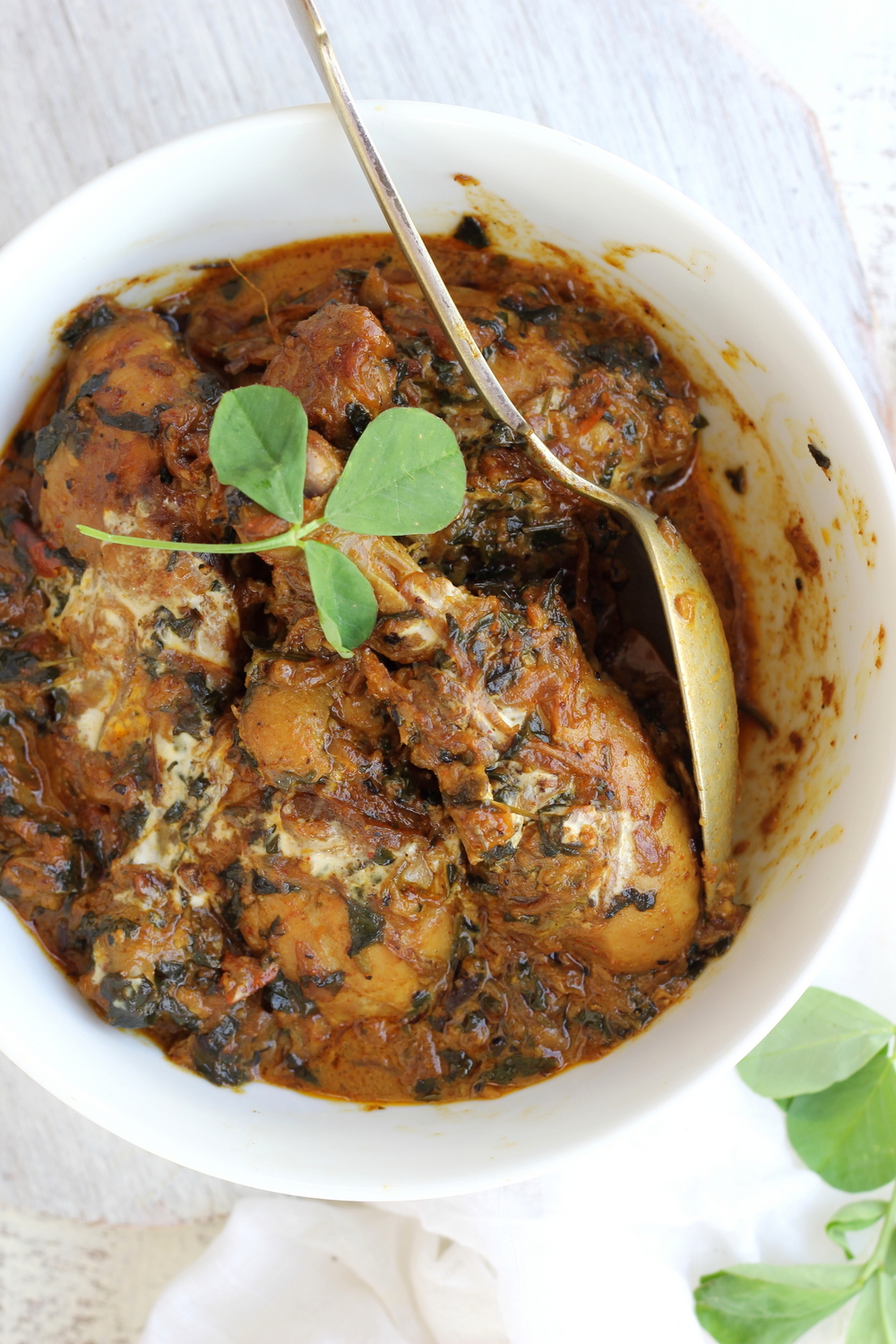
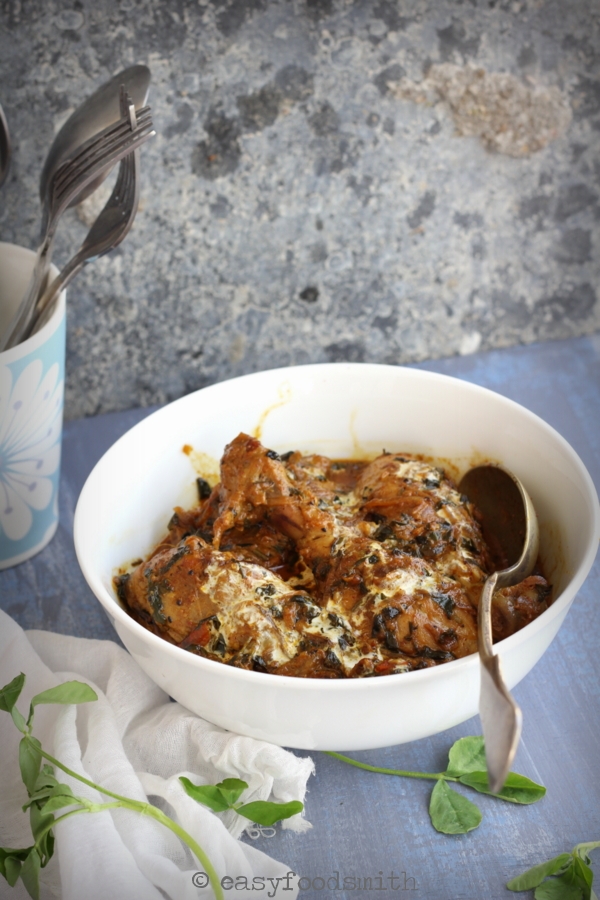
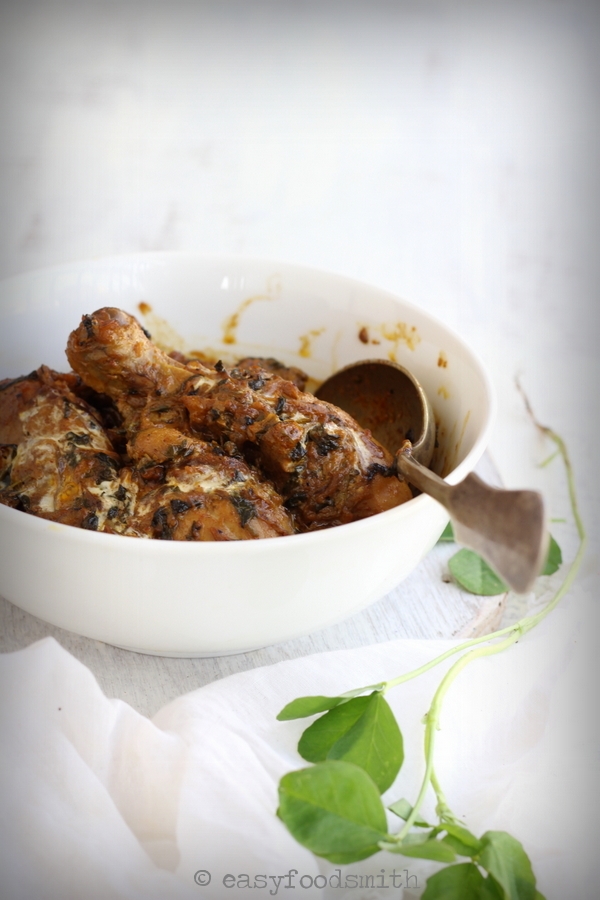
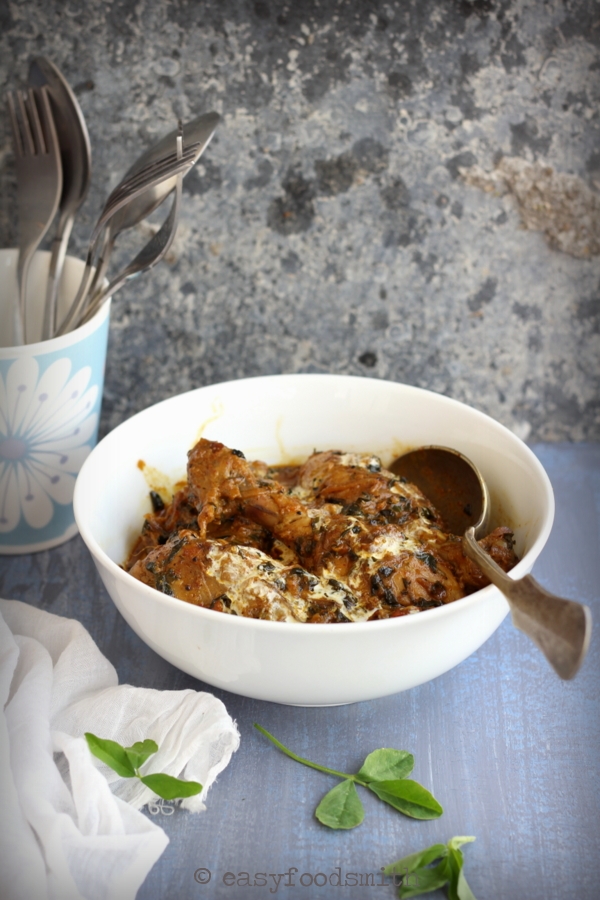
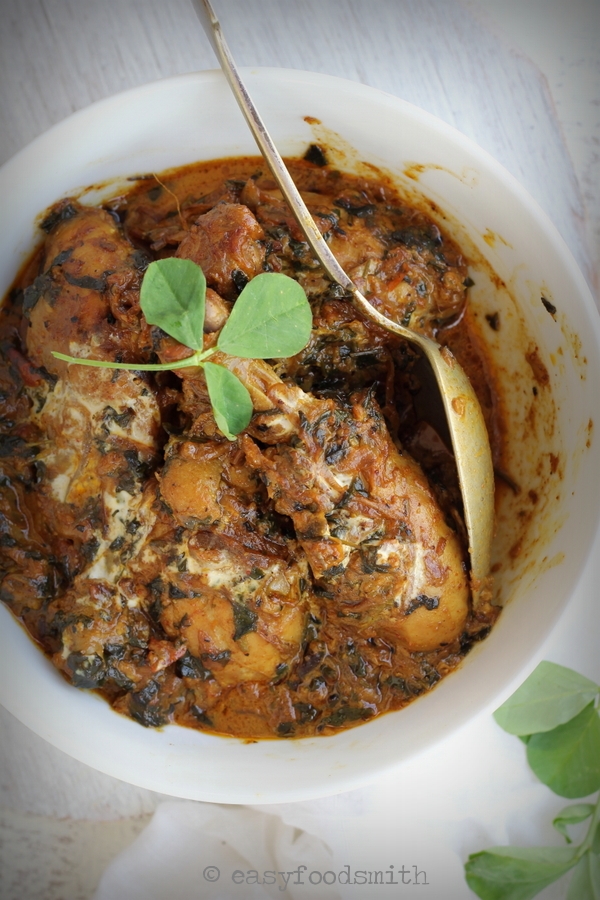

I love the taste of Methi in curries. I think the bitterness varies by taste buds. Once I felt they were so bitter, but now my taste buds have adjusted so well that I love them. I love the aroma it imparts to the dishes. Nice recipe, I have to try this.
You rightly said Shibi. Our taste buds do mature and start accepting certain foods as we grow. I too love methi in my curries – dried or fresh.
Oh WOW. You have me captivated by this recipe. I really love Indian food and curries SO much (in fact, it was just my birthday last weekend and I requested we go to this amazing hole-in-the-wall Pakistani place, it was SO GOOD!) I love fenugreek and I happen to have some from another recipe so I must try this! Thanks for sharing!!
Thanks Nagi. I hope you get to try it soon.
I really like the way you cook and the spices that you use. Pinned!
Thanks Cheri…really kind of you to say that 🙂
I love dark chocolate too, dark chocolate melting in the mouth is perhaps the best feeling in the entire world. But karela, no way! 😀
Love the chicken curry. Simply want to grab a drumstick off the screen and enjoy!
Hahaha…karela is definitely not a veggie most people like. However, I suggest that you try the stir fry recipe at my blog and I am sure your opinion about karela will definitely change. If a kid can relish it, I am sure you would too 🙂
he he…for all this time i thought u are a vegetarian 🙂
This is such a flavorful dish, awesome pics
Perhaps you have missed my posts on fish curries. However, I think your perception is an indicator to me that I should be posting more chicken and lamb recipes 😉
I love fenugreek and this curry looks so comforting and tasty!
It is indeed Angie and it is wonderful winter curry.
Delicious chicken curry did you methi leaves of methi seeds, because recipe says half cup methi dana.
Thanks Swathi for bringing the error to my notice. It is methi seeds only but I erred the amount. It is meant to be 1/2 tsp and not 1/2 C.
I’m at a loss for words. This looks stunning! And absolutely full of flavor!
This sounds wonderful! I didn’t use to be familiar with fenugreek until I had a baby, then I learned all the benefits it has for new mothers, so I learned lots of ways to work it into teas, foods, and more. I know I would love this, YUM!
It’s funny how you write about dark chocolate and bitter foods. I don’t mind bitter foods at all, in fact I quite like them, but for some reason, I just can’t get into dark chocolate! I think I must love my butter and cream too much 🙂
Methi is one of my favourites. I adore it with pretty much everything. I put a handful of kasuri methi in my curries but never tried one like this, it looks amazing. I will take a trip to the desi store to get some fresh methi 🙂
BTW, I haven’t been getting your emails in my inbox and I even checked my spam, nothing there. I knew about this new post because I saw it on my FB feed, and then you commented.
I’ll sign up again, but I wonder why it just stopped.
I too am a kasuri methi addict. As for the update via emails, my IT guy has apparently fixed the problem. Please do let me know if you have received further updates (the latest being a post on Curry Essential Spices)
I haven’t met a curry I didn’t like and this is no exception. I know you kitchen smells amazing as this cooks!
this looks great and love that you used yogurt
Thanks Rebecca. As a habit, I always marinate chicken and lamb in yogurt coz it helps tenderize the meat, making it succulent. (for certain recipes, I even use raw papaya as a tenderizing agent) It also apparently helps kill any germs that might be there (that piece I read somewhere).
Fenugreek is good stuff, and one of those ingredients I use all too rarely. I do use the seeds, but almost never the greens. This dish looks super — tons of flavor. Thanks.
This chicken dish sounds and looks so good…I love all the spices in it…I would love to have this with a bowl of rice…yum!
Hope you are having a great week 🙂
Wow, this sounds amazing! I love coffee so would be very upset if caffeine stopped agreeing with me 🙂
I am definitely not a dessert person but when its spicy curry, I light up immediately. I also used the seeds though over here I can only find the dried leaves. The addition of yogurt is so good and I can imagine how it would be worked well into this yummy and inviting curry.
Ah! dark chocolates are not mine infact other than white chocolate I don’t eat any 🙂
Wow I can’t stop drooling over these gorgeous pics! I really love methi in my curry. I make it a bit differently but I am sure going to try this way next time. Thanks for the recipe
So many layers of flavor here! A beautiful dish and it must be divine to taste!
I’m not familiar with the word Fenugreek, but your curry certainly looks good. I’m sure it tastes just as good! Enjoy your coming weekend! xoxo
A delicious looking and sounding dish! I’d really love to try this recipe…
Cheers,
Rosa
I am in awe with this dish! I would definitely be eating this with my fingers so I could lick them and get all those wonderful flavors!!!
Like many, meethi in curries are the best. SOmething about it right?.
Dark chocolate a big fan and don’t have to feel too guilty about it:).
I had to mention this, your home page with all the antique utensil, love it, want them all.
Have a super weekend.
Thanks Asha. I wish you lived near by so I could lend you the utensils 😉
Methi has such a unique flavor, and I love that you’ve combined chicken and fenugreek. Looks and sounds delicious!
I absolutely LOVE curries and this looks divine! So delicious and full of wonderful flavors.
A fabulous curry. I love your gorgeous photography.
Methi adds so much flavour to various dishes, this looks awesome 😀
Cheers
Choc Chip Uru
Such a flavorful and sumptuous meal, love it…
Really different curry to try, never saw fenugreek greens but I have some powder at home. Must see if I can make this. I have a sweet tooth but I only touch dark chocolate 😉
In case you intend to use fenugreek powder in curries (also known as kasuri methi) you would need just a teaspoon or so coz it is pretty intense.
I make a similar curry.. Yours look so tempting. I started drooling the moment I saw the pics… As usual inviting clicks
LOVED this recipe—thanks so much for sharing! My partner (who grew up in India) said it was one of the best curries he’s ever had 🙂 I used some of the spices whole, and powdered the other half so that they permeated the dish. We served with bhakri. Will definitely be making this again and again!
Hi Amanda! I am so happy you enjoyed the curry and thanks for your feedback 🙂